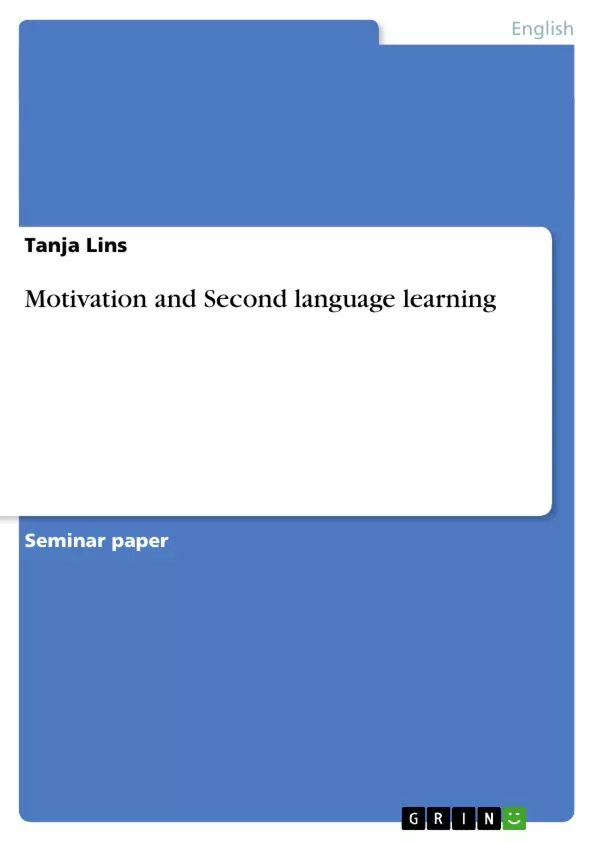Why do people learn second languages? Why do for example Australians study Japanese or Korean people study French? The answers to these questions are important, according to Rebecca Oxford (1994), because ‘motivation is considered by many [researchers] to be one of the main determining factors in success in developing a second or foreign language’ (p.12). Gardner even claims L2 motivation to be the ‘primary factor’ in L2 learning in his socio-educational model (1994, p.361). Therefore, an investigation of the components of motivation and the influence of motivation on L2 learning seems quite reasonable. This essay will focus on the concept of motivation in second language learning. Initially, the definition of the term motivation shall be discussed and this will be followed by an identification of the key terms. Then the attention shall be drawn to research results concerning the importance of motivation as influencing second language learning. The essay will discuss Gardners quantitative approach and a recent research of Ushioda shall be taken into account that seeks to provide an alternative qualtitative approach. This approach focuses on students’ beliefs and thinkings rather than on measurable and observable activity. A final chapter will focus on implications for teaching.
Inhaltsverzeichnis (Table of Contents)
- INTRODUCTION
- DEFINITION
- COMPONENTS OF L2 MOTIVATION
- GARDNER'S EDUCATIONAL AND SOCIAL PSYCHOLOGICAL PERSPECTIVE OF L2 LEARNING
- AN ALTERNATIVE APPROACH TO GARDNERS FRAMEWORK.
- RESEARCH FINDINGS ON MOTIVATION
- IMPLICATIONS FOR TEACHING.
- CONCLUSION
- REFERENCES
Zielsetzung und Themenschwerpunkte (Objectives and Key Themes)
This essay explores the concept of motivation in second language learning, aiming to understand why people learn new languages and how motivation influences their success. The essay delves into the definition of motivation, its key components, and the relationship between motivation and language learning.
- The definition and nature of motivation in second language learning
- Key components of L2 motivation, including integrative and instrumental motivations, extrinsic and intrinsic motivations
- Research findings on the impact of motivation on second language acquisition
- Alternative perspectives on motivation, such as Gardner's socio-educational model and Ushioda's qualitative approach
- Implications for teaching and promoting motivation in second language classrooms
Zusammenfassung der Kapitel (Chapter Summaries)
- Introduction: This chapter introduces the topic of motivation in second language learning, highlighting its importance in achieving success. It outlines the essay's focus on the definition, components, and research findings related to motivation in this context.
- Definition: This chapter explores the difficulties in defining motivation due to its varying interpretations across cultures and individuals. It examines different perspectives on motivation, including Gardner's definition as a combination of desire, effort, and positive attitudes, and Oxford's view of motivation as the power to achieve a goal. The chapter also considers Skehan's hypotheses regarding the origins of motivation, including intrinsic interest, external influences, and internal causes.
- Components of L2 Motivation: This chapter examines the key components of language learning motivation, including integrative and instrumental motivations, extrinsic and intrinsic motivations, and cognitive approaches. It discusses Gardner's popular “motivation construct” and the interplay of integrative and instrumental motivations in influencing an individual's motivation for learning a second language.
- Research Findings on Motivation: This chapter delves into research findings on the impact of motivation on second language acquisition. It explores the importance of integrative motivation in Gardner and Dörnyei's theories, while also acknowledging the debate surrounding its relationship to language achievement. The chapter also examines the dichotomy between extrinsic and intrinsic motivation, highlighting the potential for extrinsic rewards to undermine intrinsic motivation.
Schlüsselwörter (Keywords)
The key terms and concepts explored in this essay include motivation, second language learning, integrative and instrumental motivation, extrinsic and intrinsic motivation, Gardner's socio-educational model, Ushioda's qualitative approach, and the impact of motivation on language acquisition.
- Quote paper
- Tanja Lins (Author), 2005, Motivation and Second language learning, Munich, GRIN Verlag, https://www.grin.com/document/48569



